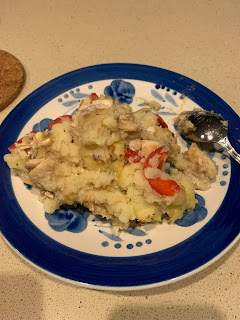I have known about this recipe since about 20 years ago when I was first introduced to it in the UK. It is one of their 'traditional' fares but I have never made it because I have never found the right fish or had leftover mashed potato.
I finally had one too many potatoes in the fridge and decided to try my hand at this pie. It also just happened that I had bought some frozen fish fillets.
Ingredients
7 to 8 frozen fish fillets, cut into chunks (allow to thaw a little to facilitate cutting)
2 tbsp corn starch
4 potatoes, peeled and cubed
1 capsicum, cubed
2 tsp curry powder (or whatever preferred seasoning)
2 tbsp of butter
1 tsp chicken stock powder
Salt, white and black pepper to taste
Method
1. Prepared the mashed potato. Bring cubed potatoes to a boil with enough water to cover. Takes about 10 to 15 minutes once the water is boiling. Be careful, it will overflow!
2. While potatoes are cooking, prepare the fish. Line a shallow baking tin. Add in the cubed fish fillets and toss in corn starch, salt, white pepper, and curry powder. Ensure that the fish is laying in a single layer.
3. Top with capsicum, again laid in a single layer.
4. Place into the oven and bake for 15 minutes at 180 deg C until the fish is semi-cooked.
5. Once potatoes are fork tender, drain. Mash with the butter, chicken stock powder, salt, and black pepper.
6. Spoon over the mashed potato on top of the capsicum and smooth the top. Draw designs with a knife or fork. The more nooks and crannies, the most crispy!
7. Bake for 20 minutes at 200 deg C. If the mashed potato has not turned golden brown, turn on the grill and grill on high for about 5 minutes.
8. Serve immediately!









